
Featured Blog | This community-written post highlights the best of what the game industry has to offer. Read more like it on the Game Developer Blogs or learn how to Submit Your Own Blog Post
Everybody Shake! The Making of Spaceteam - Chapter 1 of 3
After helping to develop some of the biggest blockbusters in gaming history, Henry Smith gives himself 12 months to succeed at creating games on his own.

Everybody Shake! The Making of Spaceteam
Written by David L. Craddock
Table of Contents
Chapter 1: La-La Land
Spectacle and Pageantry
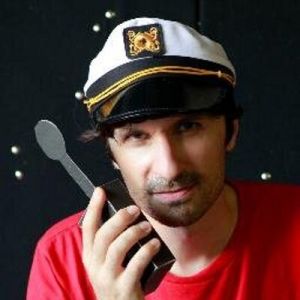
On May 13, 1999, the Entertainment Software Association kicked off its annual E3 event by rolling out the red carpet for the who’s-who of the gaming industry. Console news dominated the event. Nintendo announced the GameCube, then code-named Dolphin. Sega branded its forthcoming (and apparently sentient) Dreamcast console with a release date of 9/9/1999 and a price point of $199.99. Not to be outdone, Sony, which had announced the PlayStation 2 a few months earlier, vowed that the system would deliver in-game graphics on par with pre-rendered cinematics, and offered a real-time rendering of Final Fantasy VIII’s breathtaking ballroom scene as a teaser of things to come.
All around the show floor, developers peddled their latest and greatest. Blizzard Entertainment and Blizzard North let attendees go hands-on with Diablo II. Peter Molyneux of Lionhead Studios promised players the sun, moon, and stars in Black & White. Rare turned heads by demoing Perfect Dark, proof positive that the N64 still had gas left in the tank in the wake of the GameCube announcement. Publisher Activision brought along id Software’s Quake III: Arena to remind everyone that the PC was still the go-to platform for fast and chaotic shooters. Valve Corporation’s Team Fortress 2 touted a gritty visual style, only to drop off the radar until 2007, when it resurfaced sporting a cartoonish, stylized look.
Publishers festooned every square inch of floor and booth space with frills. Giant speakers thundered and crackled. Professional wrestlers posed alongside their polygonal counterparts, rendered on monolithic screens. Ring announcer Michal Buffer, sparkling in his pressed tuxedo, grabbed a dangling silver microphone and hyped getting ready to rumble in Midway’s Ready 2 Rumble Boxing, a launch title for Sega’s Dreamcast. Scantily clad “booth babes” blew kisses and strutted their stuff, tantalizing passersby to sidle on over for a chance to play a game and pose for pictures.
The videogame industry circa 1999 was a land of giants. On the grand stage of E3, the biggest of the big boys came to play, and for bright-eyed newcomers aspiring to become professional fun makers, experience and demo programs were the coins of the realm. Upon setting foot in the LA Convention Center, Henry Smith was, if not a king, at least a prince.
“I went to E3 on my own money, with another friend who was doing the same thing. I took a bunch of résumés and gave them out to as many people as possible. I think I had a demo CD of a new game I was working on at that time, but that game never came out. It was much too ambitious, but I figured it would be something to show, at least.”
Smith, in the thick of his sophomore at University of Waterloo in Canada, didn’t see how he could miss an opportunity to attend E3. A tidal wave of flashing screens and thunderous sounds—mostly screams and explosions—rolled over him as he went from booth to booth, shaking hands and bequeathing his résumé, game demo, and (fingers crossed) a good impression.
That fall, he got a call. Irrational Games, a relatively new start-up studio, wanted to bring him in for an interview. He ran the gauntlet and was offered a position as a programmer. Looking back on his auspicious beginnings, Smith couldn’t believe his luck. His venture to E3 that spring had put him in the right place at the right time.
Smith’s humility obfuscates the true reason he got his foot in the door. Luck plays a part in landing any dream job, but in Smith’s case, he’d been hard at work building virtual worlds for years. He was hungry, intelligent, creative, and perhaps most importantly, driven.
Hyper Games
“I can’t remember when I started playing games,” Smith reflects. “Even before I had a computer, I was making my own board games and card games. I’m not sure where that drive came from, but anytime I went over to a friend’s house and saw on a console—we weren’t allowed to have consoles growing up—I was enraptured.”
Bereft of Super Mario Bros. and Space Invaders, Smith took a roundabout path toward games and game development. His father was a computer scientist specializing in artificial intelligence, an occupation that guaranteed early and frequently exposure to mainframes and minicomputers. The SPARCstation, a pizza-box-style computer from Sun Microsystems, was his first. A Macintosh Plus followed, and Smith’s first bite of Apple’s sweet fruit triggered an explosion of creativity.
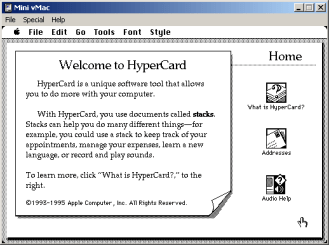
His instrument of choice was HyperCard, an Apple program aimed at budding programmers. HyperCard programs consisted of stacks of cards capable of holding data such as text fields, graphical elements like images and animations, sounds and music, and buttons. The graphical user interface (GUI) was simple and intuitive: click an element, such as a button or check box, and drag it onto a card, the same way one moved files and folders around on the Mac’s desktop-style interface. To bring a card’s elements to life, users wrote scripts in HyperTalk, a programming language that resembled English. Scripts could scan for input such as a keystroke or mouse click, and take an appropriate action: animate an image, play a sound, or, upon clicking a card’s buttons or filling in its text fields, jump to another card in the stack.
Naturally, Smith harnessed HyperCard to create small games. To learn new tricks and methods of executing on data, he loaded in HyperCard stacks and dissected them to learn how they worked. Before long, he was making graphics-heavy games featuring sprites (two-dimensional images) that moved around and responded to user input.
Some of his creations were inspired by other games. One of his favorites was TaskMaker, a roleplaying game released in 1989 by Storm Impact. Players assume the role of a protégé assigned tasks, or quests, to complete by a master. During a quest, players will come across obstacles such as monsters, illusionary walls, and traps, and must manage stats such as Food and Health.
Presented in black and white (par for the course for Mac software published in the late ’80s), Task Maker unfolded from a top-down view. Maps consisted of tiles, and upon winning, players were granted the ability to alter the map as they saw fit. Intrigued by the idea of generating terrain, Smith wrote a map editor for TaskMaker. Pulling up his program, he could build his own maps tile by tile, object by object.
Amazingly, Smith undertook his self-appointed task when he was only 12. He couldn’t finish it alone. His computer scientist father gave him guidance, and he even reached out to the game’s authors, David Cook and Tom Zehner, for help. Impressed by his ambition—and by the fact that Smith endeavored to hack their game for the purpose of learning rather than piracy or to cheat—they sent him a colorized edition of the game.
Opening the package that his free copy of TaskMaker marked a major event in Smith’s life. It was the first time he had ever received a form of payment for his labor. Inspired, he commenced playing and programming harder than ever. Then, in 1995, a new game caught his eye: DMA Design’s Lemmings, the enduring puzzle game where players assign senseless critters to various roles toward the purpose of leading them to a level’s exit while preventing them from wandering aimlessly off of cliffs.
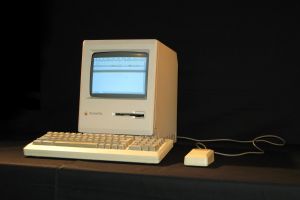
Inspired by Lemmings, Smith created a puzzle game called Squish. The object of Squish is to guide the titular character to the exit on each of the game’s 90 levels. Exits are initially gated, so players must first locate and trigger mechanisms to open them. Perhaps as a means of paying forward the courtesy TaskMaker’s authors had shown him, he also wrote an editor that players could use to make levels.
Entering high school, Smith continued plugging away at Squish. “That started off as a HyperCard game. It was in black and white. There weren’t distribution mechanisms [for games made in HyperCard], so I decided to rewrite it in C++, which I was learning in high school. C++ is a very complicated language, and I was still learning, so the code was pretty terrible. But I ended up getting something working.”
Carving off an early slice of Squish, he uploaded a demo to various bulletin boards and websites. After 10 levels, players viewed an advertisement for the full version of the game, attainable by mailing an order form and a check for 10 pounds to Smith’s address.
Receiving a free game for his TaskMaker editor had amazed Smith, but the response to Squish blew him away. Order forms poured in, and not just from friends and neighbors. He amassed a collection of letters from Japan, Sweden, and other countries. Each contained the requisite check and order form, but many contained personal letters from fans exclaiming over how much they (and in many cases, their children) loved playing Squish.
“I was 15 to 16 years old and getting these letters, and money too. I did most everything by myself. I got my brothers to help me out with some of the level design, but other than that, I built the game, I advertised it to some extent, and mailed floppy disks to people. It was really fun.”
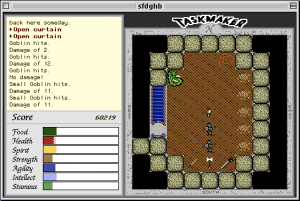
Smith entered University of Waterloo as a computer science student and embarked on the school’s co-op path: four months of classes followed by four months of practical, on-the-job education. Negotiating with the program’s administrators, he hashed out an arrangement to devote one co-op period to writing a game from home. Sorting through ideas that had been knocking in his head around for years, he started in on Peregrine, an isometric RPG that would spin a yarn about gods, a magical spyglass, and the player’s connection to stars. Less than two months in, he realized the design was far too ambitious to create within the confines of the co-op period. It got put on the backburner in favor of a smaller, more achievable game.
Squish became a centerpiece in Smith’s résumé-portfolio package when he and a chum from University of Waterloo ventured to Los Angeles for E3 in 1999. Irrational Games took a liking to the breadth of his work, and more importantly, his industriousness.
“I’m sure my initiative helped. When I’m involved interviewing people, that’s something I look for as well: if someone has the initiative to do something on their own, and has that motivation. You can teach them any skills they might need on the job; the program you’ll use are going to change every six months anyway, or they might be proprietary to the company. Those skills are less important than motivation and drive.”
The Mass Effect
Henry Smith’s breakout job as a junior programmer at Irrational Games, almost wasn’t. “There were only about 15 to 20 people, and I was there as basically an intern. Initially an unpaid intern until I made a few desperate phone calls a couple of weeks before I was scheduled to start, saying, ‘Uh, no, I thought I was going to be paid for this job.’ Luckily, they agreed to pay me something.”

Secure in the fact that he would indeed receive a paycheck for his efforts, Smith slipped right into Irrational’s stream. The company had been co-founded in 1997 by ex-Looking Glass Studio employees Robert Fermier, Jonathan Chey, and Ken Levine. At the time Smith joined, the tiny studio had recently released its action/RPG/survival-horror thriller System Shock 2 to critical acclaim. The team shifted focus to developing a game for the still-unreleased PS2 called The Lost.
According to information divulged from Irrational’s semi-regular “From the Vault” series of Web diaries exploring the studio’s cancelled titles, The Lost was an amalgamate of popular game conceits: a survival-horror adventure portrayed from a third-person perspective, like Konami’s chilling Silent Hill series, combined with nonlinear elements of Nintendo’s The Legend of Zelda series and Capcom’s Devil May Cry, such as giving players the freedom to tackle levels in an order of their choosing.
At first, Smith enjoyed working on The Lost. He was one of only four or five programmers in the studio, so he got to touch practically every line of code being written. When 2002 rolled around, he was fidgety. Game programmers lived and died according to the shipped titles listed on their résumés. Smith had been at Irrational nearly three years and still had no shipped games under his belt. He made the decision to leave and enrolled at University of Waterloo, polishing off the requirements for his bachelor degree in mathematics.
Finally, in August 2004, Smith interviewed at BioWare Edmonton and secured a job that led to his first shipped product—Dragon Age: Origins, the inaugural entry in the studio’s long-running high-fantasy RPG. Smith was brought on as the senior graphical user interface (GUI) programmer, a job into which he poured a great deal of passion and time. As the senior programmer on the user interface, he had autonomy over its look and feel. When his work wrapped up, he transferred to BioWare’s Montreal studio and lent his expertise to the GUI for Electronic Arts’ Dead Space 2.
Over time, Smith became more and more enamored with designing interfaces. “That was my specialty, and has been for many years now. I like doing it, and I care about good UI. It really bothers me when games have bad UI. It’s also something that nobody else seems to care about. Companies don’t seem to give it enough thought or people. Often, there isn’t even a user interface designer; the UI just gets designed by programmers and managers, and 15 people will have their fingers in the pie.”
Smith was in his element working on Dead Space 2. The first game, released in 2008, had garnered acclaim for its chilling atmosphere, sci-fi story, and tight controls. Those controls were a natural extension of the game’s interface. Instead of cluttering the screen with ammo counters and hit points, EA Redwood Shores (EARS) melded those and other UI elements intothe gameplay: ammo was displayed on the player’s current weapon, a health bar grafted to the back of protagonist Isaac Clarke’s spacesuit drained as he took damage, and his inventory was displayed as a span of squares that opened as a holographic projection from the player’s suit.
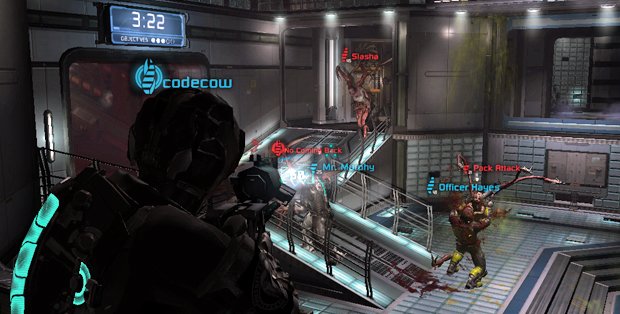
Dead Space 2 deviated from the road paved by its predecessor. Alongside a single-player-only campaign crafted by series creator Visceral Games, Dead Space 2 featured a suite of multiplayer modes designed by BioWare Montreal. The idea was that splitting up the workload would allow the developers at Visceral to concentrate on the single-player portion, while the crew up in Montreal handled the multiplayer modes. Smith and his colleagues strived to incorporate multiplayer-only elements, such as how many objectives the player’s team had accomplished, and the names of their partners and opponents, in an organic way. The work was satisfying; the real challenge lay in appeasing the devs at Visceral, who often seemed territorial over the Dead Space IP.
“There were definitely some challenges working remotely, because we were sort of an unknown team in Montreal. I remember the people working on the main game were a bit hesitant for us to come in and start changing stuff. We had to work to gain their trust.”
In 2010, Smith finished his obligations on Dead Space 2 and moved on to speccing out the multiplayer mode for Mass Effect 3. Known as Galaxy of War, ME3’s multiplayer component groups players into squads of four and tasks them with completing special missions that influence the outcome of their personal stories in the single-player campaign. More exciting to Smith, however, was that many of his old friends from BioWare Edmonton transferred to the Montreal location, making his work on Mass Effect 3 something of a reunion. But the best part of his job at BioWare was the company’s stance on outside projects.
“I was interested in doing my own projects on the side, and BioWare let me do that for a long time. I had to basically tell them what I was doing, and give them a CD with all the stuff I had done, and they locked it up somewhere just so they could protect themselves, and me. It was sort of a mutually beneficial thing.”
To the disappointment of Smith and many of his colleagues, many of BioWare’s policies had changed for the worse when, in the fall of 2007, EA purchased BioWare for $860 million. “After EA bought BioWare, the policies on side projects became a lot more strict [sp], so it was harder for me to do my own stuff on the side.”
Smith was unwilling to jeopardize his intellectual property. Still, he needed to eat. He stayed the course at EA/BioWare until August 2012, when a confluence of events nudged him toward the exit. He’d been with BioWare for seven years, and employees were entitled to a one-year sabbatical at that juncture. More critically, he found EA’s policies creatively stifling.
“It seemed to be the right time; all those factors combined to make it the right time to leave. So, in 2012, I left to go indie full-time, and I’m still here.”
Chasing Dreams
Smith got his sabbatical off on the right foot. He and his girlfriend, singer and anthropology student Sara Breitkreutz, packed their bags and set off on a five-week trek across Europe. Arriving in Florence, Italy, they hiked to a church set on a hill, where Sara proposed to him.

Caine of Caine’s Arcade.
Smith returned home refreshed and engaged. With his personal life was on track, he turned to the primary reason for his sabbatical: developing games unencumbered by employment restrictions. “I’d purposely saved up enough money so that I could last for a year, according to my calculations, at the quality of life I was previously used to, without making any money at all. So I knew that even in the worst case, if I didn’t finish a game or if I made a game and it sold nothing, I’d still have spent a year doing something I loved. I’d have had a break, and I’d come back to the industry as a programmer.”
His plan was simple. He had approximately ten months to spend on his own projects, so he decided to divide the time between a small project and a larger one. Writing a bite-sized game first would ensure he was able to complete something, and give him invaluable experience as a solo developer. Moreover, he could parlay a small game to build a fan base that would be champing at the bit for more of his work by the time he unleashed bigger and better games.
Peregrine seemed the obvious candidate for the more time-consuming venture. Smith had hated having to set it aside while at Waterloo years earlier. One of his brothers, Daniel, had drawn beautiful artwork for the game, and he had launched a blog to share plans for the design and show off Daniel’s concepts. The blog had ended up gaining traction; one visitor went so far as to open a website devoted to news and updates on the game.

Galaxy Trucker.
But, first things first. He needed to create something manageable, yet bold enough to satisfy his natural inclination to build meaty experiences. By August, he’d settled on Shipshape, a design he’d been contemplating since leaving BioWare. Shipshape was a sci-fi game where players built spaceships and pushed deeper and deeper into space. Galaxy Trucker, one of his favorite board games, served as the primary impetus for Shipshape’s design. Galaxy Trucker sees players struggling to cobble together ships from tiles representing parts—lasers, thrusters, panels, and the like—and then explore space while avoiding obstacles like meteor showers, space pirates, close brushes with aliens, and other goings-on, repairing and rebuilding their ship when necessary.
“I thought the Galaxy Trucker mechanic would be great for an iPad game where you could actually explore a galaxy and get into a bit more depth. I was really excited to do a game like that. I wasn’t going to be copying Galaxy Trucker’s gameplay; I just wanted a simple way of building a ship like that, and exploring a galaxy.”
To date, Smith’s best ideas had been too big for tight time constraints to hold. Shipshape proved no exception, spilling outside the one-month parameter he had set for himself. Trouble was, he couldn’t come up with less grandiose ideas. Distressed and aggravated, he went to bed—and slipped fitfully into a dream inspired by a short documentary he’d watched earlier that year.
The documentary, Caine’s Arcade, was filmed by Nirvan Mullick in April 2012. In the film, Mullick follows his then-nine-year-old son, Caine, on a tour through an arcade Caine had built in the back of his dad’s auto parts store. While Mullick worked, his son had been cutting and gluing together cardboard boxes into shapes resembling arcade cabinets and attractions like skee-ball. The detail and imagination Caine had put into his project left Nirvan floored. He asked his son if he could be the arcade’s first customer. Caine agreed, and Mullick’s amazement grew as his son demonstrated the ticket and prize system he had devised to go along with some of his cardboard creations. Mullick filmed Caine going through the arcade and uploaded the video. It took off, going viral and bringing flash mobs into Mullick’s lonely store.
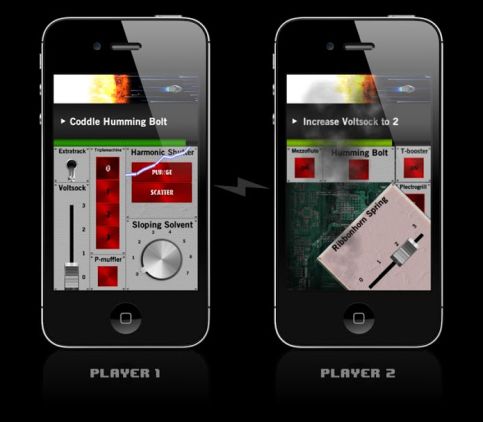
Spaceteam.
Now, Smith and his brother were standing in Caine’s cardboard arcade… except, not really. Looking around, they appeared to be in an abandoned science fair, gloomy and littered with the detritus of failed and abandoned projects. Wandering the aisles, they came to a small corner packed with arcade games. Like Caine’s makeshift cabinets, these had been manufactured from cardboard, wood, and recycled scrap. A game caught their interest. The body was old and ratty, but the front was a dashboard straight out of a Star Trek episode. Meant for two players, the game boasted two CRT monitors.
Smith and his brother sat down to play. Words arranged in hierarchical menus flickered on their screens. Above both menus, a command appeared, and the brothers deduced that it pertained to their menus. The rub was that their menus were different. Every time a command appeared, Smith and his brother searched their screens to see whose menu contained the word. Once they found it, they tapped it, triggering another command-word scavenger hunt.
Smith awoke sometime later, battling conflicting emotions yet wearing a smile. He had his one-month project.
“It was very basic, and not a fun game,” he recalls of the faux game he played in the dream. “I remember getting really angry with [my brother] because he didn’t understand how to play, so I was shouting at him. But that’s where the idea came from: having something on one screen that you had to react to on another screen, sort of necessitating communication between the two people—not just between devices, but between the people themselves.”
**
If you enjoy Episodic Content, please consider showing your support by signing up for my Patreon, or via a one-time donation through PayPal.
Read more about:
Featured BlogsAbout the Author(s)
You May Also Like

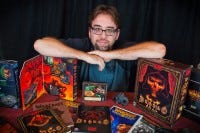





.jpeg?width=700&auto=webp&quality=80&disable=upscale)








